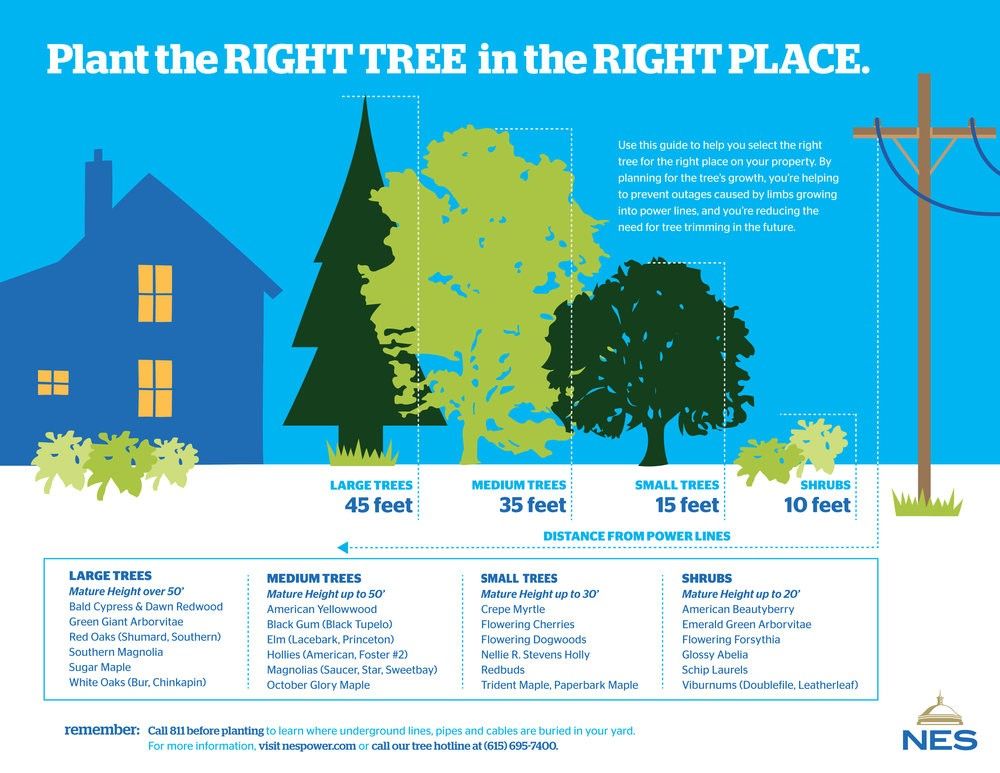How to prune fruit trees
How To Prune Your Fruit Trees
Within a few years of lovingly planting fruit trees, most folks find themselves with scraggly overgrown bushes, rather than the Garden of Eden they had envisioned. The key to keeping fruit trees attractive and productive is annual pruning.
Worry not, pruning is not the brain surgery it has been made out to be. Curmudgeonly Master Gardener types may tell you that different fruits are pruned in different ways, which is true to an extent, but there is a simple three-step process that works for the vast majority of fruit trees.
Outside of the tropics, most of us are dealing with pome fruits (apples, pears and quince) or stone fruits (peaches, cherries, apricots, plums – anything with a pit). This three-step method works for both.
Though summer pruning is not harmful to the trees, winter makes things easier. Without the tree’s foliage, you can really see what you are doing.
STEP 1: Clean Up
Start by pruning away any wood that is dead, damaged or diseased – a. k.a. the three D’s.
Are sprouts coming from the base of the trunk? If so, remove them – technically they’re called ‘suckers’ and they originate from the rootstock rather than the fruiting variety grafted on top.
How about suspiciously straight sprouts growing from some of the main branches? These erect, perfectly vertical branches, or “watersprouts,” – should be removed as well.
With all these clean-up cuts, it’s important to prune the branches back flush to the larger limb they’re growing from – don’t leave little stubs.
STEP 2: Thin Out
The goal of thinning is to allow light and air into the canopy, which boosts fruit production and reduces problems with pests and disease.
First, remove any branches that grow downward, toward the center of the tree or that cross paths with another branch.
Once these are out of the way, stand back and take a look. The goal is to have evenly spaced branches splaying out in a pleasing, fractal-like pattern from the center.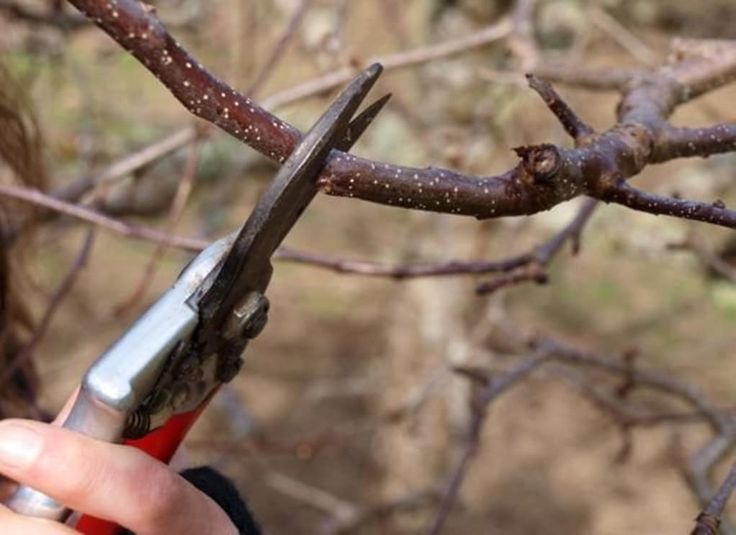
Do you see places where multiple branches compete with each other? You might find two or more growing from a single crotch at a narrow angle, for example, or from different points but in a parallel fashion, one hovering over the other.
If so, thin out all but one branch, retaining the branch with the healthiest appearance and best crotch angle (roughly the 2 o’clock or 10 o’clock angle from the center of the tree). Wider angles can break when laden with fruit and narrower angles lead to bushy growth and fruit that is too high to pick.
Next, continue to thin the tree until there is a good 6 to 12 inches of air space around every branch. The smaller the branches are, the closer they can be to each other.
As with your clean-up cuts, all thinning cuts should be made flush to the branch.
STEP 3: Head Back
The last step is the easiest – you’re basically giving the tree a haircut.
The idea is to prune back the outermost growth of the tree so the branches become shorter and thicker as they grow, rather than long and gangly.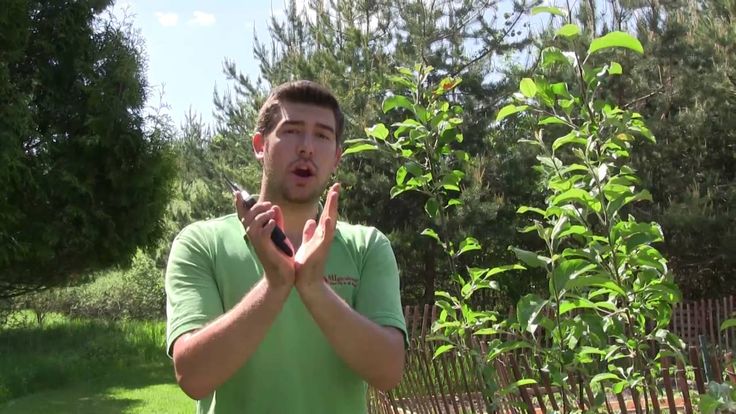 This keeps them from snapping under the weight of the fruit, but pomologists (fruit scientists) will tell you that it also causes the tree’s hormones to activate growth lower in the canopy, making for smaller, more fruitful trees.
This keeps them from snapping under the weight of the fruit, but pomologists (fruit scientists) will tell you that it also causes the tree’s hormones to activate growth lower in the canopy, making for smaller, more fruitful trees.
Heading back the tree means cutting off 20 to 30 percent of last year’s growth. You can distinguish last year’s growth from two-year-old growth by the wrinkly ring of bark encircling each stem. Depending on the vigor of the tree, this may be anywhere from two inches to 4 feet back from the tip of each branch.
Unlike the previous steps, these cuts will be made part way into each branch. Exactly where you make the cut is important, too. Prune each branch back to a point one-quarter inch above a bud that faces the direction you want that branch to grow in the coming year. If there is another branch close by on the left, for example, prune back to a bud on the right side of the branch.
PRUNING TIPS
- Sharp shears make for clean, easy cuts – if you don’t know how to sharpen your own, many neighborhood hardware stores often offer the service for a small fee
- As a measure of disease prevention, dip the blades of your pruning shears in solution of isopropyl alcohol for 30 seconds to disinfect them before moving on to prune another tree
- Clean up the pruned wood from around the tree and dispose – especially if it contains any diseased material
Brian Barth formerly lived in America’s fruit basket, aka California, where he ran an edible landscape design company, but moonlighted each winter as a fruit tree pruner.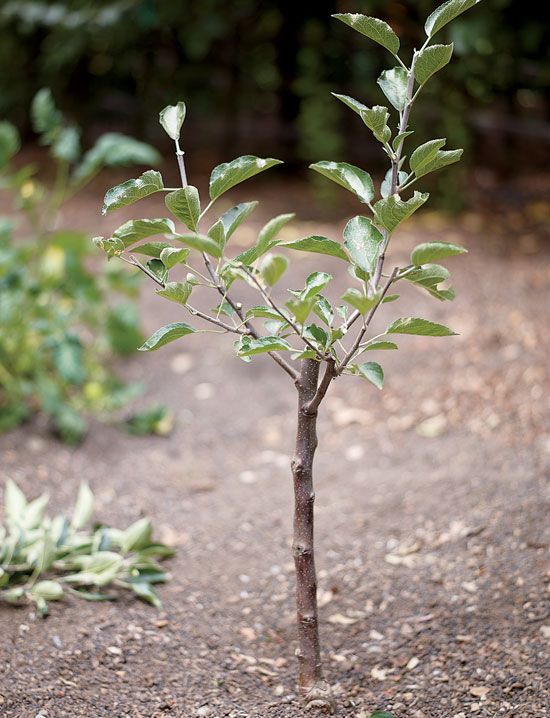
PRUNING FRUIT TREES THE RIGHT WAY (FOR THE BEST HARVEST)
Annual pruning (the right way) is so important for the health of your fruit trees. It can lead to a long, healthy and productive life for your trees and will increase the yield and quality of your fruit.
After a long winter on the homestead, we’re excited to put our wintertime rhythms behind us and take advantage of longer days and more sunshine.
Planning your spring garden BEFORE you plant, knowing these 5 tips to have your BEST garden season ever, and knowing the best steps to prepare your garden for winter are all helpful to set you up right for the gardening season.
In the same way, knowing a few things about pruning your fruit trees is extremely beneficial when you get that first sunny spring day and want to tackle all those unruly branches.
We don’t recommend taking your sheers and just guessing when it comes to trimming branches, but with the following tips, you should be well on your way to a healthier tree and more fruitful harvest.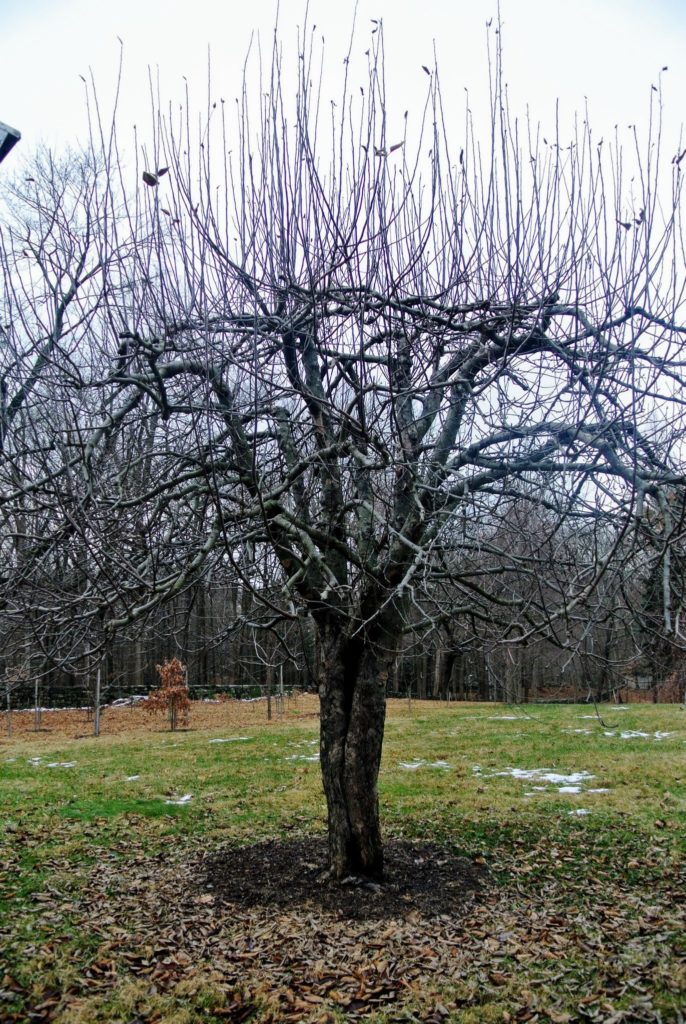
Why should you prune fruit trees?
- Control the size – Pruning fruit trees helps to control the size of the tree. Keeping the size of the tree at a manageable level can be advantageous so all the fruit can be reached to be picked.
- Renew fruiting wood – When you prune a tree you’re helping to stimulate the growth of new fruiting wood. This fruiting wood is the wood that create more fruit spurs and will bear fruit. A neglected tree will eventually have much more non-fruit producing deadwood.
- Access – We want to be able to get into the tree to pick the fruit for ease of pruning each following year. It’s also helpful to have easy access if an organic spray is needed for any reason.
- Different goals – It’s important to know your goals before pruning so you know which method to follow.
 It may be an option to not prune your trees at all if the quality and quantity of fruit isn’t in your main goal.
It may be an option to not prune your trees at all if the quality and quantity of fruit isn’t in your main goal.
Do all fruit trees need to be pruned?
In short, IT DEPENDS!
This is a tricky question because it really depends on your goals for the tree, how old the tree is, and how much you want to manage the tree in years to come.
Sepp Holzer in Austria has chosen to not prune his trees at all. He found in his studies that if you prune a tree you will ALWAYS need to prune a tree. But if you let a tree grow naturally, it will grow up and not get unruly or become a tangled mess.
If you want a low maintenance tree and the production that comes out of the tree isn’t your main goal, then you can just let the tree obtain its natural form.
Benefits of Pruning Fruit Trees
- Maximize the harvest – By pruning your fruit tree you will stimulate the growth of new, fruit-bearing wood.
- Control the growth – You will be able to control the direction of the new growth, allowing for maximum harvest, sunlight and airflow.
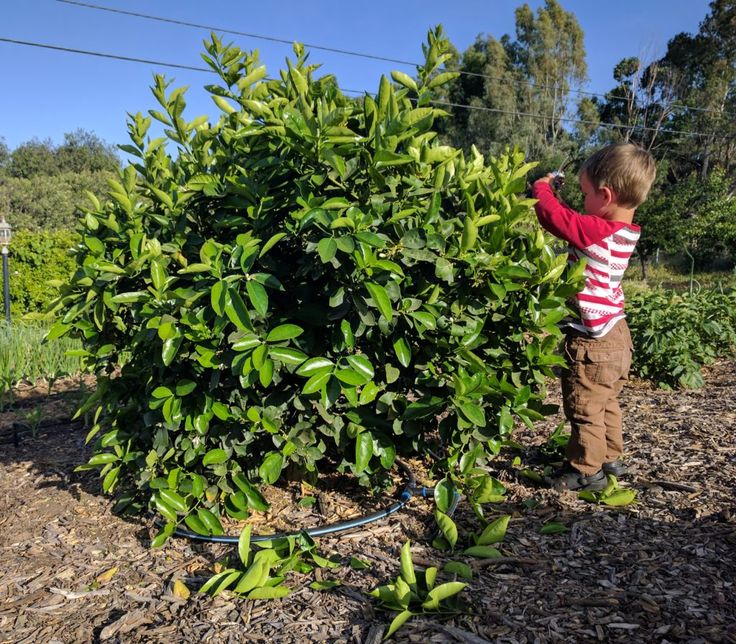
- Allow sunlight into the tree – If your tree becomes overgrown and unruly, the sunlight won’t be able to penetrate the lower branches. Over time these branches will stop producing and become deadwood. The fruit will then be at the top of the tree and much harder to harvest.
- Allow for proper airflow – You want to allow proper airflow into the fruit tree as well. For a productive tree, each fruit-bearing branch needs to have adequate airflow to grow nice and strong.
What tools do you need for pruning?
You really want to use the right tool when pruning trees. If you’re grabbing the wrong tools you can do some minor damage to the tree bark, which really isn’t ideal. Here are our recommendations:
- Secateurs – The most important tool is going to be a nice sharp pair of secateurs (or “nippers” as we call them). These will be what you use for shaping and cutting off anything that is 3/4 inch in diameter and smaller.
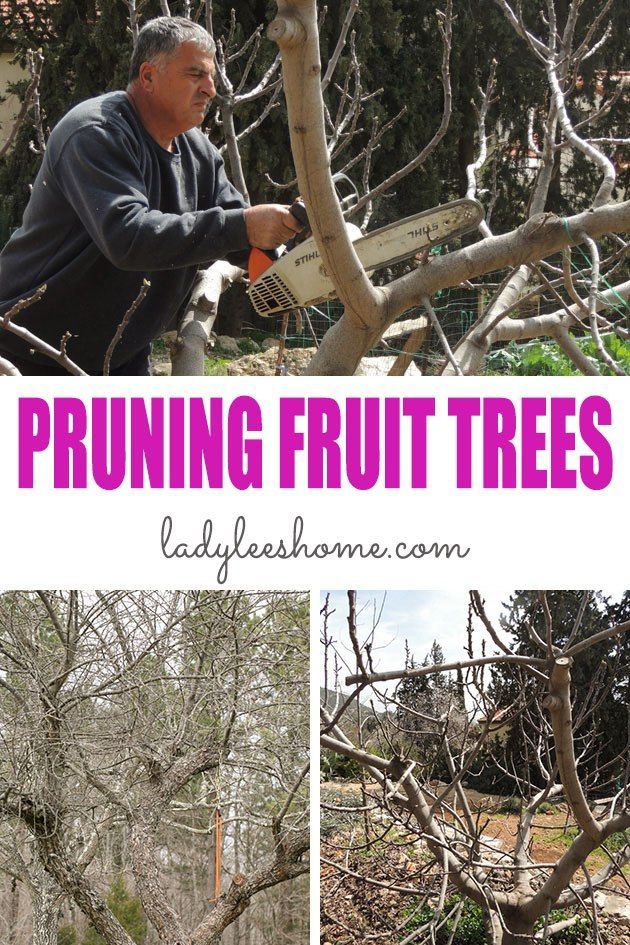
- Folding pocket saw – One of our favorite garden tools is Opinel knives. We’ve used them for 25 years and they’re a great quality tool. This pocket saw will be handy for sawing off any deadwood or branches that are about 1 inch in diameter.
- Loppers – These can be used on branches that are about 1 inch in diameter up to 2-3 inches (or whatever your strength can get through). Something to consider about using loppers is it will pinch the bark where the cut is and can cause some tearing.
- Silky Saw – This saw is great for branches that are about two inches in diameter or larger.
- Pole saw – If you’re working with a larger tree and don’t want to get up on a ladder, then a pole saw can come in handy.
- Chain saw – A chainsaw might be needed for older trees that really need some rehab, but more than likely, a Silky or pole saw should work just fine. We like to use a chainsaw to rough out the shape of a tree that’s been neglected for many years.

- A ladder – If your tree has grown up very tall, it’s likely you’ll want to have a ladder to get up to the top of the tree.
How to Prune Fruit Trees
To see a tree being pruned and to have a visual of proper cutting techniques, watch the video above. Don’t feel like you have to get the tree perfect in one year, it usually takes a few years’ time to get the ideal results.
Typically speaking, for older overgrown trees you’ll want to follow this basic three-step process:
- Get rid of anything that’s dead to get it out of the way.
- Get rid of the understory, any branches that aren’t getting light, aren’t producing and are using up energy.
- Get rid of any crossover branches to allow for more light and air.
You want to take care not to cut more than about 1/3 of the tree off in a year. When making your cuts, you want to cut the branch off right at the branch collar for a flush cut. This will allow the tree to heal the wound.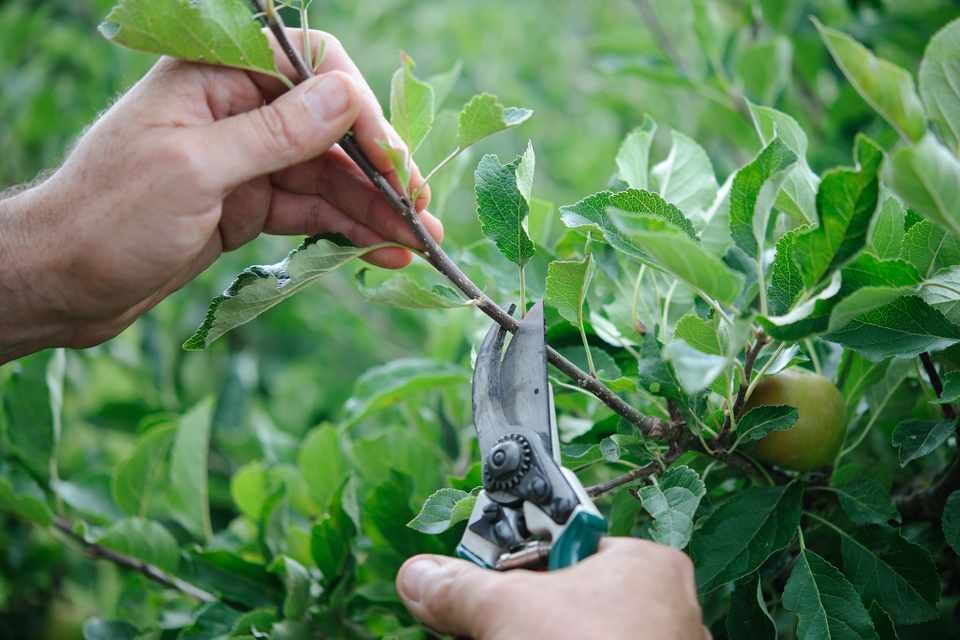
You don’t want to cut below the collar, because then the tree won’t be able to heal. And you don’t want to leave a stub, because this will eventually rot and introduce disease to a tree. (Watch the video above for an example of what this looks like.)
When to Prune Fruit Trees
Old-timers would say, “When the knife is sharp and when you have the time”.
There are reasons for pruning trees at different times of the year. Again, this all boils down to your goals and your abilities.
If your goal is to have a beautiful and productive fruit tree, then you’ll want to stick to pruning the tree when it’s dormant, with possibly a few touch-ups in the late spring and summer.
If you’re not really concerned about the fruit production of the tree, then you’ll have more leniency on when to prune.
And finally, if you want the tree to take on its natural form, then not pruning at all is certainly an option.
If you’ve had consistent problems with disease, then you’ll want to take more precautions when pruning and stick to late winter, early spring pruning when the tree is still dormant and the temperature is cooperative.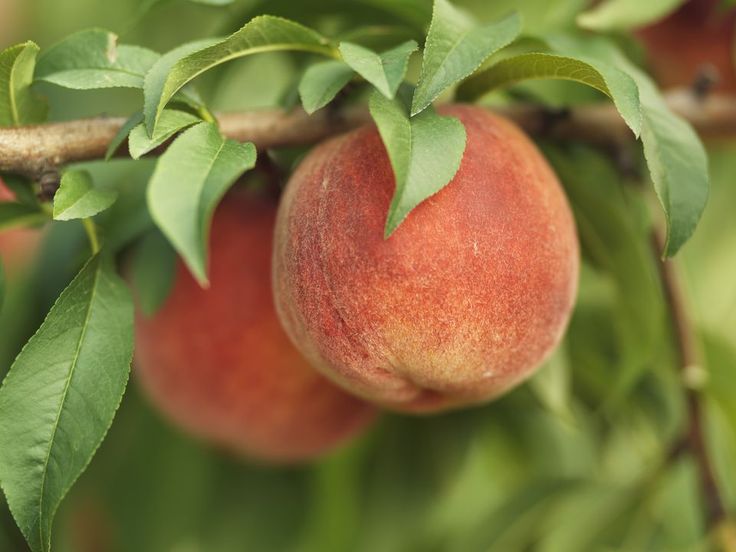
Pruning Fruit Trees in the Summer
If you prune a tree during the summertime, the tree has already used up its energy to grow the new wood, so if you cut it off during the summer, it will slow down the tree’s growth.
Again, it comes down to picking the best strategies for your own goals.
If you’re not dealing with chronic disease issues or environmental issues, then you can prune at different times of the year.
You can even do a SECOND pruning in the summer if you’ve already pruned in the winter or spring. Once you see how the new growth of your tree is coming in if you come back and re-evaluate the tree you can make some additional cuts at that time.
For example, if you missed some deadwood that’s not producing any new growth you can cut it off. Or if you notice a branch that’s grown out and is crowding some other branches, cut it off.
As we mentioned above, as long as you’re not dealing with any chronic diseases, you will be just fine pruning in the summer.
Pruning Fruit Trees in the Fall
You can prune your trees in the fall, once fruit production has completed, and this will allow you to get a bit of a headstart for the next year. However, there’s no real benefit to pruning in the fall, other than if that’s when it fits best into your schedule.
Ideally, if your goal is high-quality fruit production, you want the tree to be in its dormant state when you prune so that all the trees energy goes into producing new wood.
Pruning Fruit Trees in the Winter
Dormant pruning (late winter, early spring), which is before the buds start to swell and after the sub-zero temperatures. If you prune when you might have some sub-zero freezing temperatures, you may have some damage to the wounds.
If you prune a tree during its dormant state, you’re going to force the growth of the tree once it becomes active in the spring.
Pruning Fruit Trees in the Spring
Pruning trees in the spring is just fine, and in our case, the ideal time because the threat of really cold weather is behind us, but it’s still cold enough that the buds on the trees haven’t swollen.
What should a properly pruned fruit tree look like?
Before you begin pruning your tree, whether it’s a new sapling or an old, overgrown tree, you want to consider the scaffold or “skeletal structure” of the tree.
There are two types of tree structures, either open base shape or central leader (or modified central leader).
Each of these will typically have 3-5 main scaffold branches. You can think of these as the “bones” of your tree. They’re what all the other branches will come off of and will form the basic shape of your tree.
A properly pruned fruit tree will have branches that allow for light and air to penetrate the entire tree, even to the lower branches.
You don’t want branches on your tree that are pointing into the center of the tree, these will be difficult to tend to and difficult for harvesting any fruit.
You also don’t want any “water sprouts” which are typically upright shoots that develop from dormant buds on the trunk or scaffold branches.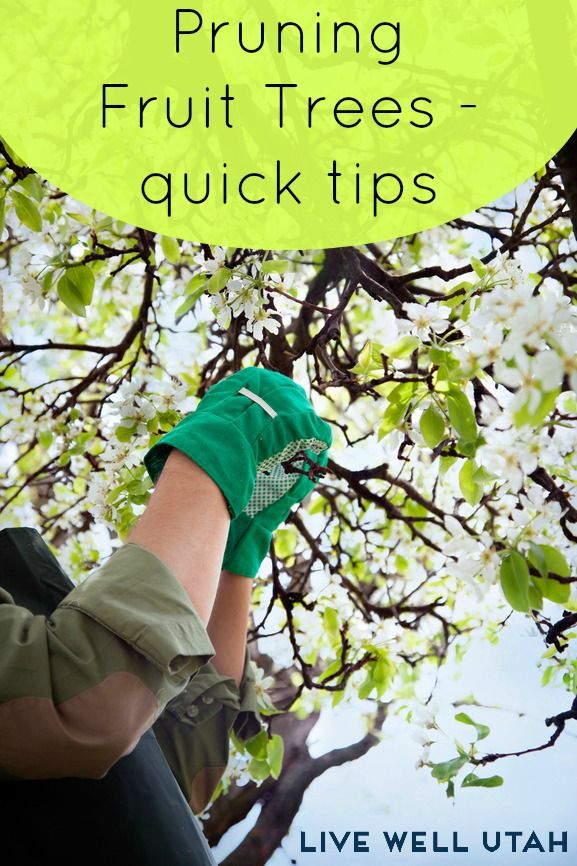 Oftentimes, the pruning or removal of larger branches will stimulate dormant buds to grow.
Oftentimes, the pruning or removal of larger branches will stimulate dormant buds to grow.
Watch the video above for more tips on how to clean up a mature fruit tree.
Are different fruit trees pruned differently?
Fruit trees are all pruned very similarly, following the same basic principles, however, you’ll want to prune different fruit trees at different times of the year.
Pear and apple trees will be pruned very similarly, ideally in the late winter, early spring before the buds have swollen, but after the threat of sub-zero temperatures.
Stone fruit should be pruned AFTER the trees flower because the tree is much dryer and the risk of introducing disease is much less.
If you have more questions…
For more information, or to reach out to Casimir Holeski, visit him on Facebook at Boundary County Restoration Project, I.M. Tree Crops, or Casimir Holeski.
How to prune fruit trees: tips for beginners
Pruning fruit trees and shrubs is one of the most important annual operations, without which no plant can grow normally, develop and give full yields.
It is necessary to prune fruit trees in order to correctly form their crown, to prevent its thickening, which interferes with the access of light and oxygen to the branches and leads to the emergence of diseases and pests.
Without pruning, the yield of both stone and pome plants drops sharply, the fruits become small and tasteless.
There are different types of pruning, some of them are too difficult for a beginner gardener, and not always necessary. In this article, we will show you how to prune fruit trees with the least amount of effort and using the simplest tool that everyone has.
We have already talked about how to prune fruit trees in our articles: How to care for cherries, How to care for pears, Frost-resistant cherries, How to grow plums.
HOW TO CUT FRUIT TREES AFTER PLANTING
Pruning of young plantings begins at the age of three. It is necessary for a tree to form a crown correctly and quickly. Such a formation has been carried out for several years. And here it is important not to make mistakes, since an incorrectly formed crown will be very difficult to correct in the future.
Such a formation has been carried out for several years. And here it is important not to make mistakes, since an incorrectly formed crown will be very difficult to correct in the future.
The main thing is to correctly create the frame of the future tree. As a rule, two types of pruning are used in amateur gardens: sparsely-tiered and non-tiered. The first is the simplest and most accessible for any novice gardener. It is equally good for both stone fruit and pome crops.
In the first two years, fruit trees mainly grow the root system, and the growth of the aerial part is rather small. In the third year, the intensive growth of the tree itself begins, and if you do not start shaping it, then it will turn into a long thick “whip” with weak side branches.
Pruning of young fruit trees starts from the central conductor. It is shortened to a height of 75 cm, leaving up to 10 buds on it, from which new shoots and side branches will form. Thus, the first tier is laid.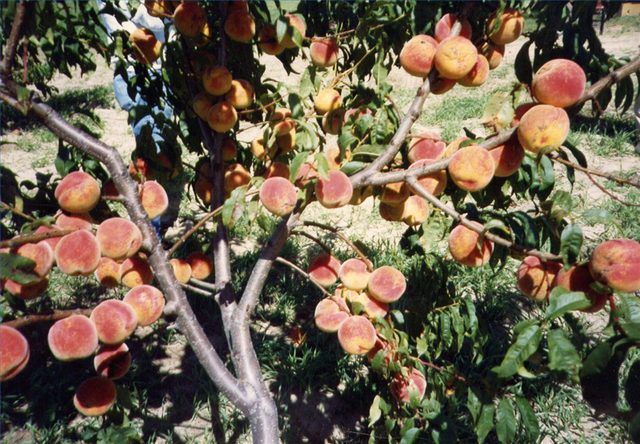
The following spring, damaged and weak branches are removed, leaving the 3 strongest. This will be the second tier. In subsequent years, the third, fourth and fifth tiers are formed in the same way.
When the tree reaches a height of four meters, cut the center conductor above the top branch to stop the growth of the tree, otherwise it will be quite difficult to care for it. Your crown has been formed.
HOW TO TRIM Mature FRUIT TREES
Annual pruning of fruit trees promotes the formation of new shoots, increases the number of flower buds, relieves the crown of the tree from thickening, improves the taste of the fruit, increases yield, limits the growth of the tree and facilitates its care.
This operation is carried out in the spring - at the end of March - beginning of April, before the start of bud break.
Pruning mature plants differs significantly from shaping a young tree. As a rule, it is limited to two operations: shortening and thinning.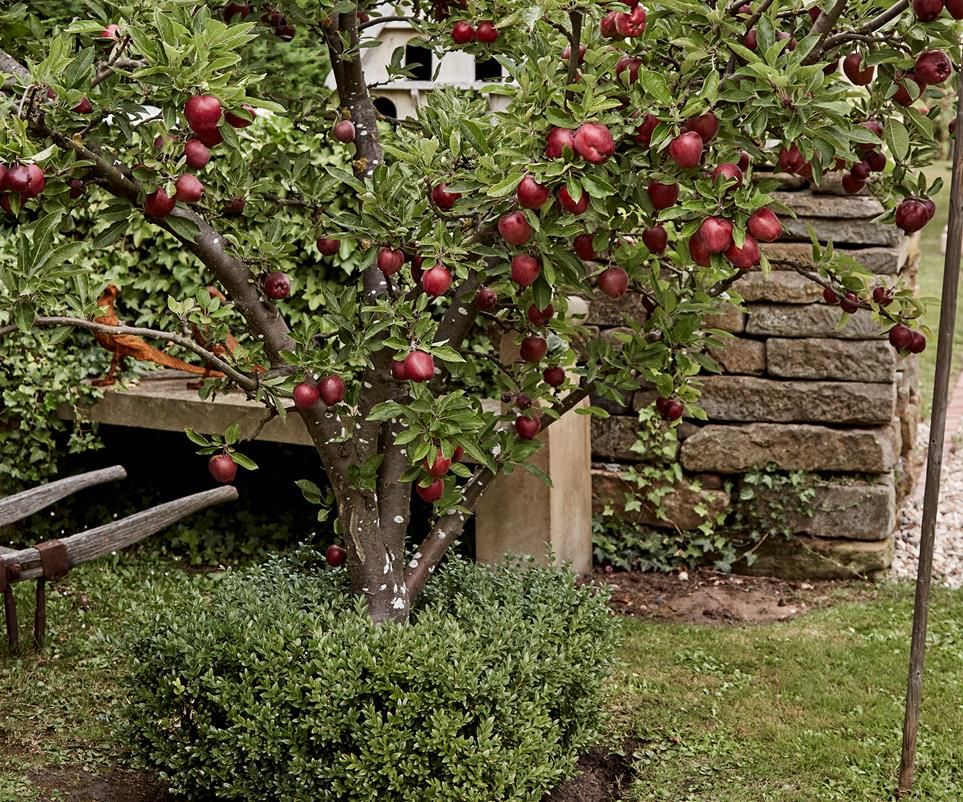
Shorten branches to encourage shoots and buds to grow. A cut on annual branches must be made above the bud, and on a long-term one - above one of the branches.
This operation promotes the rapid growth of shoots below the cut. These young shoots will quickly begin to grow fruit twigs.
Thinning is necessary to improve access to sunlight and air circulation inside the canopy. This contributes to the formation of large, even fruits and prevents the appearance of diseases and pests.
During thinning, cut out all branches growing inside the crown or at an acute angle to the trunk. The latter can cause winter breaks in the tree.
Before pruning, all broken, withered and weak branches are removed, and then they begin the main work.
You can prolong the life of old trees with rejuvenating pruning. It is made for trees older than 18 years. The easiest way to rejuvenate is to shorten all branches by 2/3 of the length.
FRUIT TREE PUTTER
For pruning, you will need a short-handled pruner, a long-handled treetop pruner and a sickle-shaped garden saw, as well as a garden pitcher for covering tree wounds.
All garden tools must be sharpened and disinfected immediately before starting work. Immediately after cutting off the branches, it is necessary to cover the cut with garden pitch.
Pome crops are pruned first, and then stone fruits.
Do not delay pruning, because after the start of sap flow, it is no longer possible to prun fruit trees. Stone fruit crops can be especially affected by this.
Pruning of fruit shrubs begins at the end of April.
Pruning fruit trees in spring - tips for beginners and beyond
Have you been looking for a scheme for pruning fruit trees in spring in detail? We have collected for you schemes and recommendations for apple, pear, cherry, plum, sweet cherry, peach and apricot in one material. Save to bookmarks!
In order for this season apple, pear, cherry and other horticultural crops to truly please you with an excellent harvest, in no case should you neglect the spring pruning of fruit trees. This procedure should be approached with caution, because it is worth overdoing it - and the tree can weaken or even die, not to mention poor fruiting or its absence.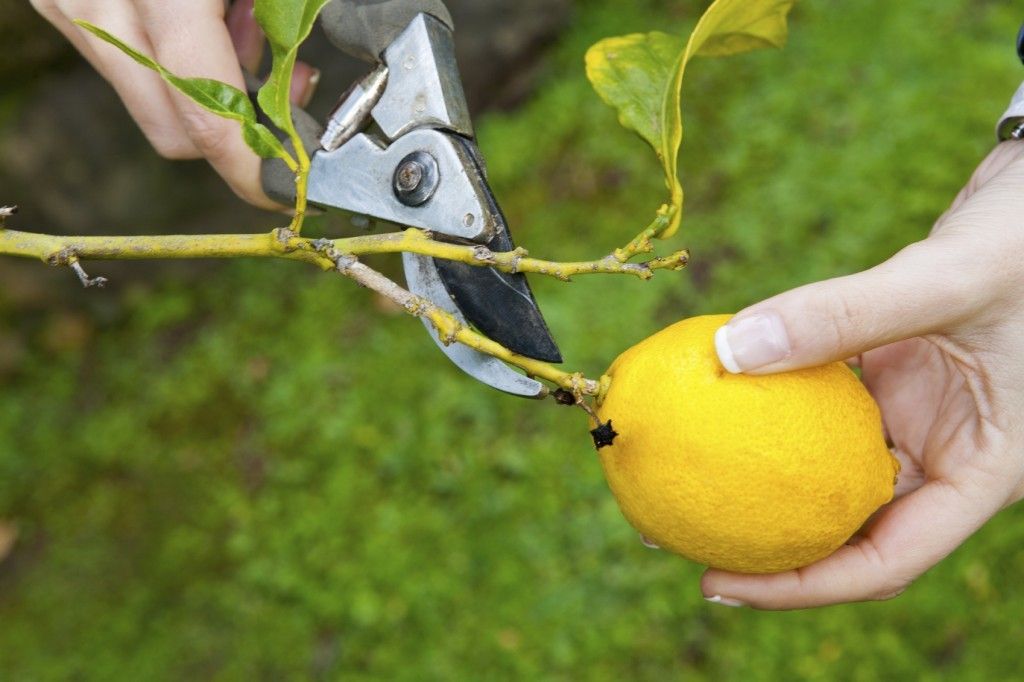
For example, when starting the spring pruning of apple trees, it should be taken into account that about three or four dozen leaves feed only one fruit!
Timing of tree pruning in spring
An important issue in tree pruning is when to do it. If this procedure is carried out too early, while the temperatures are still low, the tree may not tolerate frost. If you tighten with pruning before the start of sap flow, the plant will "cry" for a long time.
The ideal weather for "mowing" the garden is clear, slightly frosty, with an air temperature of at least -5°C. In the middle lane, the timing of pruning trees in spring is usually limited to the period from mid-March to mid-April.
Important nuances of spring pruning of fruit trees
Many novice gardeners who pick up a pruner for the first time make the same mistakes, and failure to meet deadlines is just one of them. What is important to remember when starting spring pruning of the garden?
1. Inventory preparation. The tools you use for pruning must be sharpened and disinfected. Otherwise, you risk not only causing unnecessary injury to the tree, but also infecting the site of damage.
Inventory preparation. The tools you use for pruning must be sharpened and disinfected. Otherwise, you risk not only causing unnecessary injury to the tree, but also infecting the site of damage.
For better sharpening, the tool can be pre-soaked for half an hour in salt water (1 tbsp per 1 glass of water).
2. Pruning young trees. Over-pruning of non-fruit bearing trees should be avoided. The essence of the procedure should be to remove diseased, damaged, thickening crown or competing shoots with skeletal branches, as well as shortening annual growths to subordinate the branches to the central conductor.
3. Cutting technique. Shoots that you want to remove completely must be cut into a ring without leaving stumps. In order not to break off the bark when cutting a thick branch, first make a notch from the underside, and only then completely cut the branch from above.
4. Attention to the kidneys. Cut carefully so as not to accidentally hit the buds with the blade.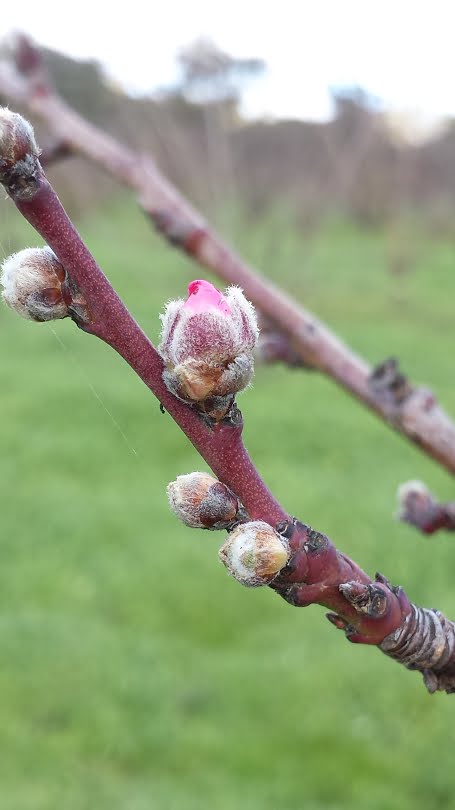 When shortening to a kidney, the secateurs are brought in from the side of the adjacent branch, placing it at an angle of 45 degrees in the direction from the base to the top of the shoot. The cutting blade should be 1-2 mm below the base of the kidney, and the second blade should be 1-2 mm above.
When shortening to a kidney, the secateurs are brought in from the side of the adjacent branch, placing it at an angle of 45 degrees in the direction from the base to the top of the shoot. The cutting blade should be 1-2 mm below the base of the kidney, and the second blade should be 1-2 mm above.
Bud pruning
Apple pruning in spring
The essence of spring pruning of young apple trees is to form a symmetrical crown. The first pruning is carried out immediately after planting. The stem is shortened to a height of 80-90 cm. If there are lateral shoots, 3-5 of the strongest, directed in different directions, are selected and shortened by 1/4-1/3 of the length. If there are no side shoots, this procedure is carried out in the spring of next year.
Skeletal branches should be cut in such a way that the central conductor rises 20-25 cm above the upper ones, and the upper branches are shorter than the lower ones.
In subsequent years, the scheme for pruning apple trees in spring involves the removal of all dry, frozen, damaged shoots, all branches thickening the crown, growing towards the center. It is also important to observe the subordination of the branches and not allow the rest of the skeletal branches to be higher than the central conductor.
It is also important to observe the subordination of the branches and not allow the rest of the skeletal branches to be higher than the central conductor.
The basic principles of pruning apple trees are presented in the following video:
Columnar apple trees are formed vertically, respectively, and the principle of their spring pruning will be somewhat different.
Rejuvenating pruning of apple trees in spring requires special care. If you see that the skeletal branches are rotten, rotten and obviously unviable, no pruning will help save the tree, but, on the contrary, will only bring its death closer.
Pruning starts with large branches. When pruning old apple trees, it is better to shorten or remove a few large branches than many young shoots. So it will be easier for the tree to endure this painful procedure. In trees that are too tall, the central conductor is also shortened by about a third, forming a crown from side branches in subordination to it.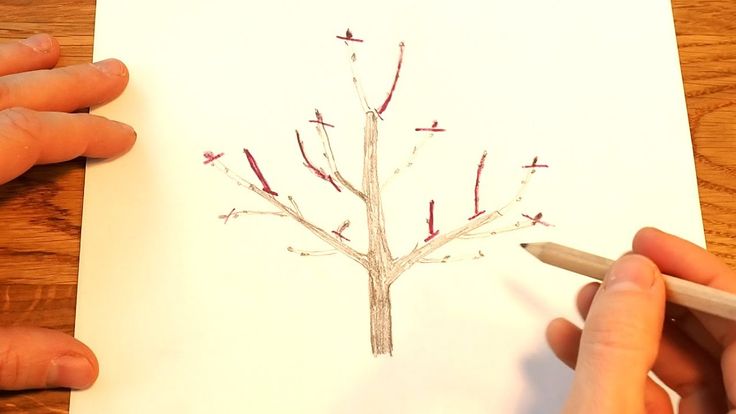
For more detailed instructions, look in our material How to prune an apple tree in spring - tips for beginner gardeners
Pruning a pear in spring
In fact, spring pruning of pears is little different from pruning an apple tree. The schemes for the formation of both trees are approximately the same.
The main difference is that if the branches of an apple tree are cut into a ring, then the branches of a pear tree are cut into a lateral shoot. The fact is that a strong pruning of this culture provokes excessive formation of tops.
Like an apple tree, a pear tree is cut for the first time immediately after planting: the central conductor is shortened to 80-90 cm and all side shoots of the seedling are cut off.
Starting from the second year, young pears are formed so that the tree has several tiers of 3-5 skeletal branches diverging like a fan in each, subordinate to the central conductor (they should be 20-25 cm below the central conductor).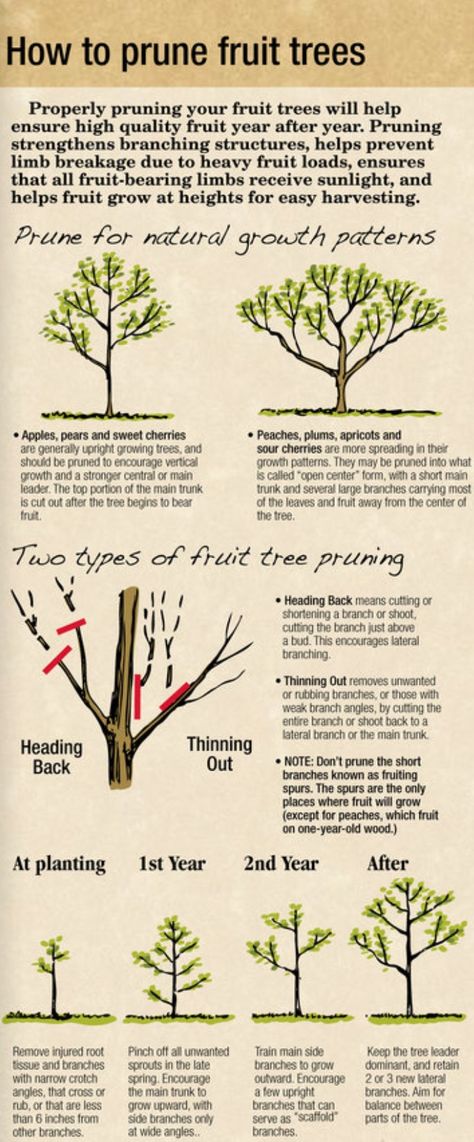
Pruning old pears includes not only the removal of frozen, dry, damaged shoots, but the pruning of all side branches that grow vertically or inward, compete with skeletal branches.
To force a branch that has begun to grow upwards to develop horizontally, it is pruned into a strong outer lateral bud. If necessary, they also tie a branch to a peg stuck in the ground in order to bend it a little. This method is good for old pears with a dense crown, which may not survive strong anti-aging pruning.
How to do it with the least stress on the tree, see the video:
Pruning a peach in spring
It is difficult to grow a peach in the middle lane, but it is possible. One of the main stages of caring for this tree is competent pruning, in which the crown is formed in the form of a bowl with a very low trunk.
Immediately after planting, the stem is cut to a height of 20 cm above the grafting site.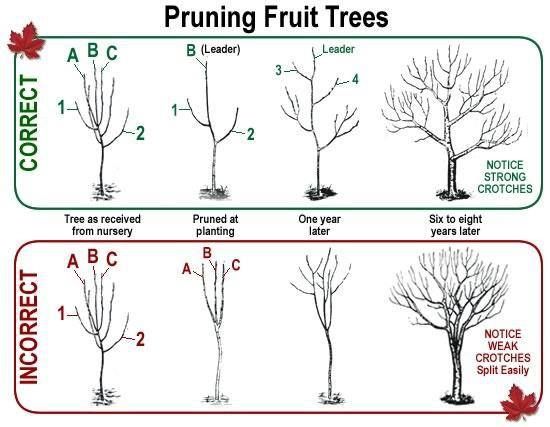 This is necessary so that the fruit branches are laid low. Thanks to this, sleeping buds will be covered with a layer of snow in winter.
This is necessary so that the fruit branches are laid low. Thanks to this, sleeping buds will be covered with a layer of snow in winter.
The peculiarity of the peach tree is that it bears fruit on annual shoots. Therefore, when pruning, old branches do not need to be spared.
In colder regions, where freezing is possible, peach is recommended to be cut during flowering.
During the first "true" peach pruning in spring, young shoots are shortened to 3 buds. During the season, new shoots will grow in this place, which will bear fruit.
In subsequent years, the crown is shaped so that there are 3-5 skeletal branches on the tree. More powerful fruit-bearing shoots are shortened into replacement knots (up to about 20 cm). During the season, they will give several shoots of one-year growth, on which a crop is formed.
The skeletal branches are pruned on the bud to direct the growth of the shoot in the right direction. If you “pity” a peach and do not cut it in the spring, the crown will be exposed, and the crop will “pass” to the upper branches.
In addition, damaged, diseased, frozen branches are pruned every spring.
To make the fruits grow larger, shorten the annual growth on which they will be tied by one third.
Watch the video for details of this process:
Apricot pruning in spring
Apricot pruning in spring is slightly different from peach pruning in spring.
Immediately after planting, the central conductor is cut to a height of about 50-75 cm and all small lateral shoots are removed on the ring. The following year, 2-3 skeletal branches are selected on the tree and shortened to 20-25 cm.
ring. At the same time, the central conductor is cut so that it is 10-15 cm higher than the side branches.
In the third year of life, it is necessary to carry out spring pruning so that 3-5 skeletal branches remain in the lower tier, located at an angle of 45-60 degrees with respect to the central conductor. They are shortened to 60 cm so that new branches of the second order are "laid" at this level. The remaining shoots are cut into a ring. The central conductor should be 25 cm longer than the skeletal branches.
They are shortened to 60 cm so that new branches of the second order are "laid" at this level. The remaining shoots are cut into a ring. The central conductor should be 25 cm longer than the skeletal branches.
Shoots that are at a more obtuse angle shorten slightly less.
In the subsequent years of the tree's life, sanitary pruning is carried out in the spring: dried branches that have suffered from frost are cut off, shoots growing inside are removed to the ring. The optimal maximum height of an apricot tree is 2-2.2 m, therefore, when pruning, they try to transfer growth to lateral shoots.
Watch a video on how to do it right:
Pruning cherries in spring
There is a misconception that cherries don't need pruning at all. In reality, of course, this is not the case. It is worth skipping a few spring pruning cherries, as the shoots begin to become bare and dry, and the thickened crown will not transmit light well.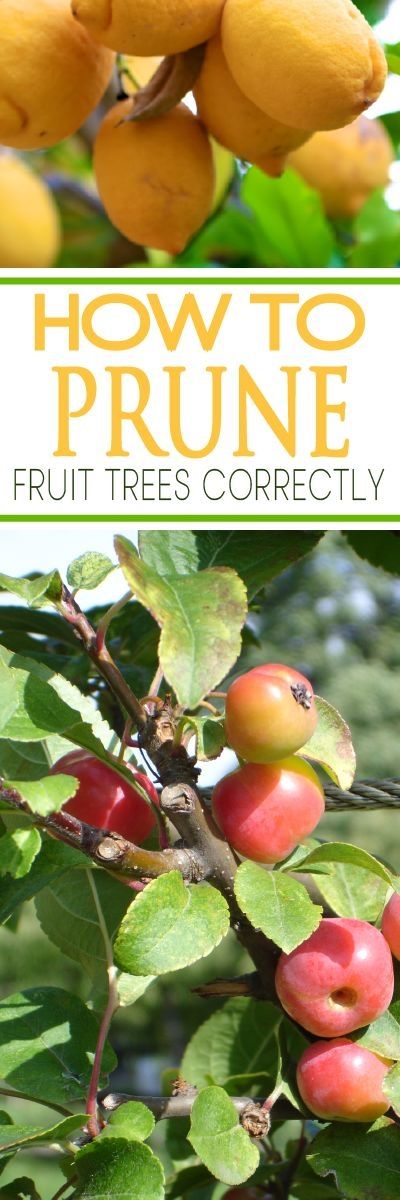 Naturally, in such conditions, the fruits will shrink, and the yield will decrease.
Naturally, in such conditions, the fruits will shrink, and the yield will decrease.
The main principle of cherry pruning is that shoots should be thinned rather than shortened.
Cut into a ring all dry branches, as well as bare shoots. To form a spreading crown, strong shoots are shortened to a bud growing outward.
Immediately after planting, all lateral shoots are removed, and the trunk is shortened by 18-25 cm. conductor.
In the second year, 5-6 strong branches are left on the tree. All other shoots that grow at an acute angle and compete with skeletal branches and conductor are removed to the ring, leaving no stumps.
In subsequent years, cherry pruning in the spring is reduced to thinning, removal of damaged and dry branches, as well as a small pruning of fruit-bearing branches to the outer bud.
A well-formed mature cherry tree should have approximately 6-8 skeletal branches growing at an angle of at least 45 degrees to the central conductor.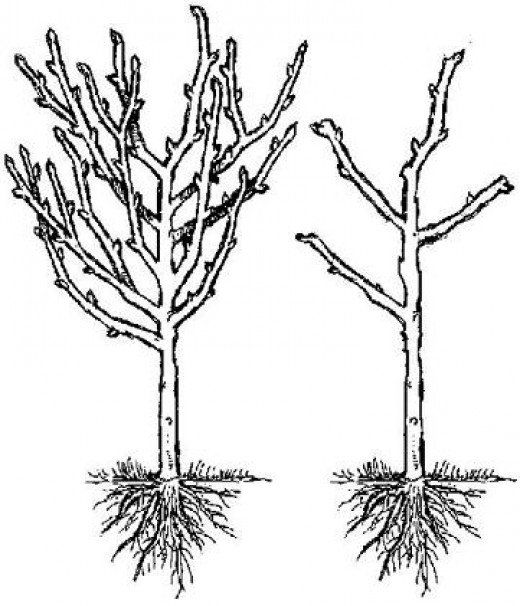
For more detailed instructions on pruning this fruit crop, see our resource Pruning cherries - forming the right crown year after year.
And the video shows it more clearly:
Pruning cherries in spring
Cherries should have a compact crown. These trees bear fruit on bouquet twigs and annual shoots, therefore, without spring pruning, cherries are exposed, stretched, and bring little harvest.
Immediately after planting, the stem is shortened to 50-70 cm. If the seedling is not cut immediately and the lower tier of branches is allowed to be laid higher than at the level of 1 m, the fruiting zone will be located too high.
In the second year of the tree's life, the skeletal branches are cut to the outer bud, shortening by about a third. In this case, it is important to remove branches on the ring that compete with the central conductor, if any.
In subsequent years, the scheme for pruning sweet cherries in the spring is as follows: side shoots growing on skeletal branches must be cut to the outer bud, shortened by a third to prevent them from being exposed.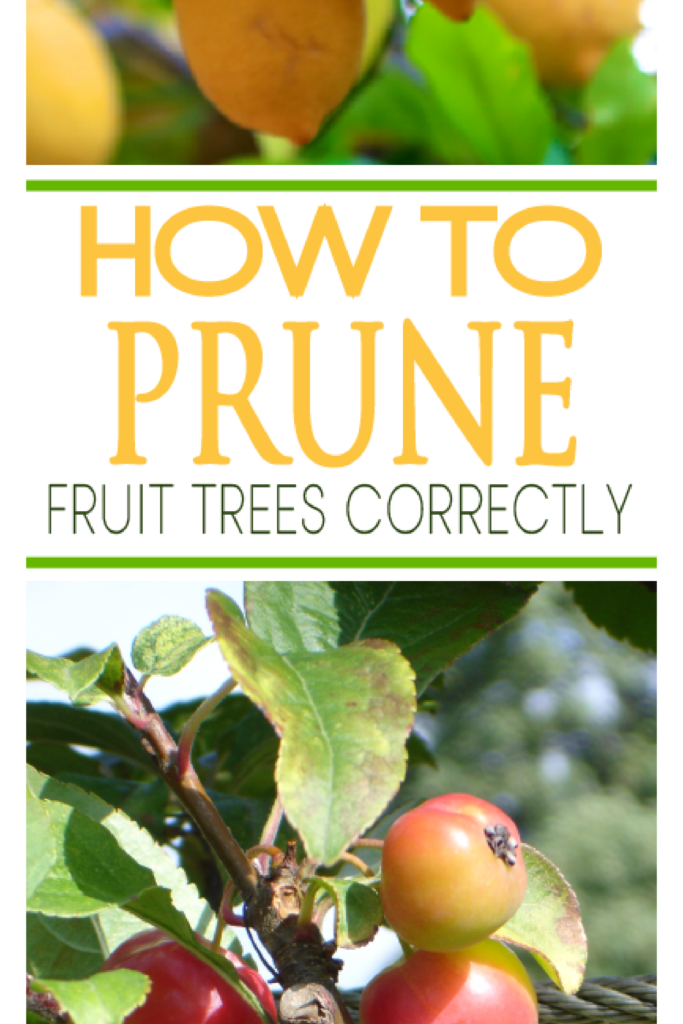 Too long skeletal branches are shortened according to the same principle, placing the cut immediately above a strong side shoot.
Too long skeletal branches are shortened according to the same principle, placing the cut immediately above a strong side shoot.
The video shows how to do it in more detail:
Pruning plums in spring
Pruning plums in spring is similar to pruning cherries. For this crop, the very first pruning immediately after planting the plant in the garden is also crucial. If during this period you "regret" the seedling and do not shorten the stem to 75 cm, it will be very difficult to form the tree correctly, if possible, then very difficult.
In the second year of the tree's life, branches competing with the central conductor are removed, and the skeletal branches are also slightly shortened, cutting them into a bud for better branching.
In subsequent years, all shoots that thicken the crown, compete with the main branches, suffer from mechanical damage, frost or become bare are removed to the ring.

